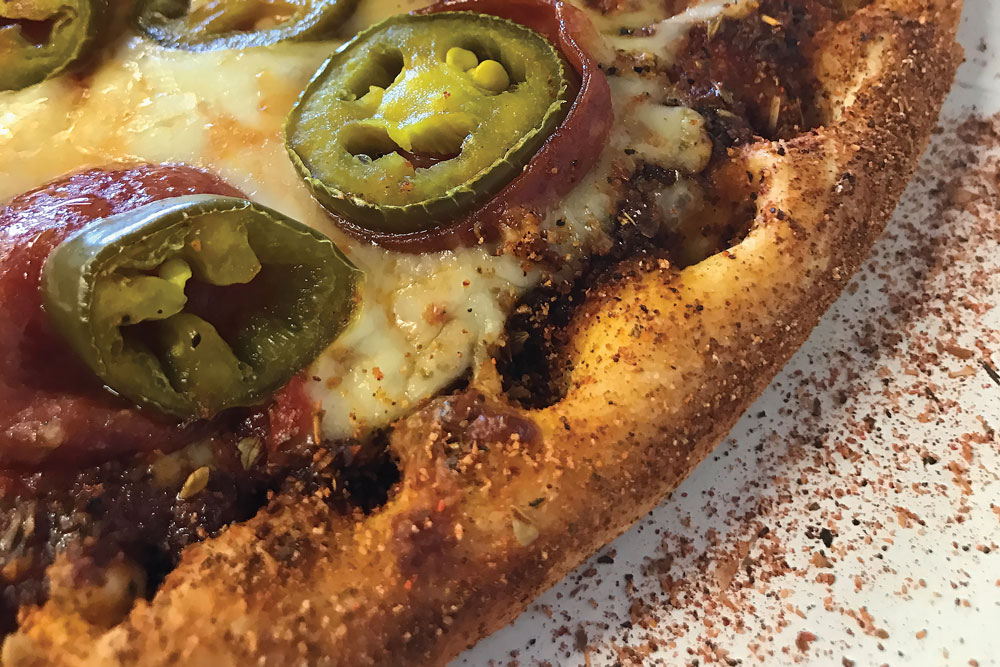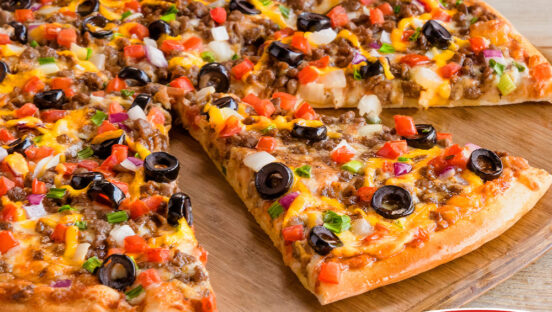The meteoric rise of fast-casual pizzerias has highlighted one defining characteristic of the modern consumer: a need for build-your-own everything. Pizza, the endlessly customizable meal, is a natural vehicle for this demand. So why aren’t there more crust varieties clogging up pizzeria menus coast to coast? We asked operators who have created fan-friendly flavored crusts to chime in on how to take the leap—and make the move successful.
Turning a Bland Crust into a Culinary Superstar
There are two main methods for creating flavored crusts, says pizzaiolo Leo Spizzirri, cofounder of the North American Pizza & Culinary Academy in Chicago: Add the ingredient directly into the dough, or atop the crust before or after baking. “When adding flavor on the crust, I love infused oils,” Spizzirri says. “Roasted garlic puree-infused olive oil can easily be brushed onto the crust before baking. The oil helps with browning, and the aroma is very appealing. I also like adding grated hard cheeses, like Asiago, on the edge of my crust before baking, which adds nuttiness and crispy texture.”
Spizzirri also adds ingredients into dough for flavor and texture. Rosemary, parsley or sundried tomatoes can turn a bland crust into a culinary superstar. However, he warns, when introducing these ingredients, add them during the last couple minutes of mixing. (Rosemary and parsley can create green dough, while sundried tomatoes can turn dough red if added at the beginning of the mix cycle.)
At Primo’s Pizza in Allen Park, Michigan, owner Timothy Estheimer keeps several flavor choices on tap for customers:
- Sesame: Sprinkled on before cooking, sesame seeds toast up nicely in the oven.
- Barbeque: Added upon request or on Primo’s BBQ Broasted Chicken Pizza, premade barbecue-flavor seasoning packs a sweet-heat punch.
- Cajun: Estheimer’s pizza makers add a prepared spice blend to the Spicy Chicken Pizza, or customers can request it on other pies.
- Garlic Butter: Premade liquid garlic easily spreads on the crust, prebake.
- Garlic Butter Parmesan: After spreading on garlic butter, employees add a generous shake of Parmesan cheese to the crust.
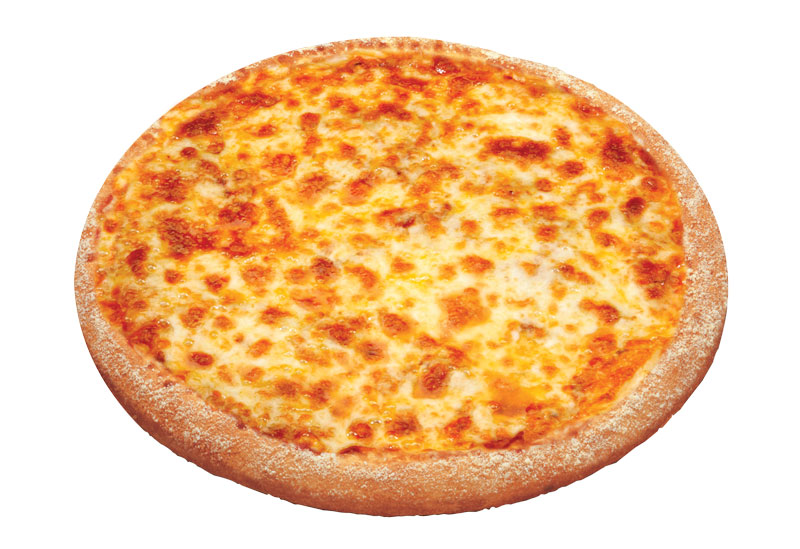 |
|
Hungry Howie’s has built a pizza empire around specialty crusts, including limited-time-only flavors once per quarter. |
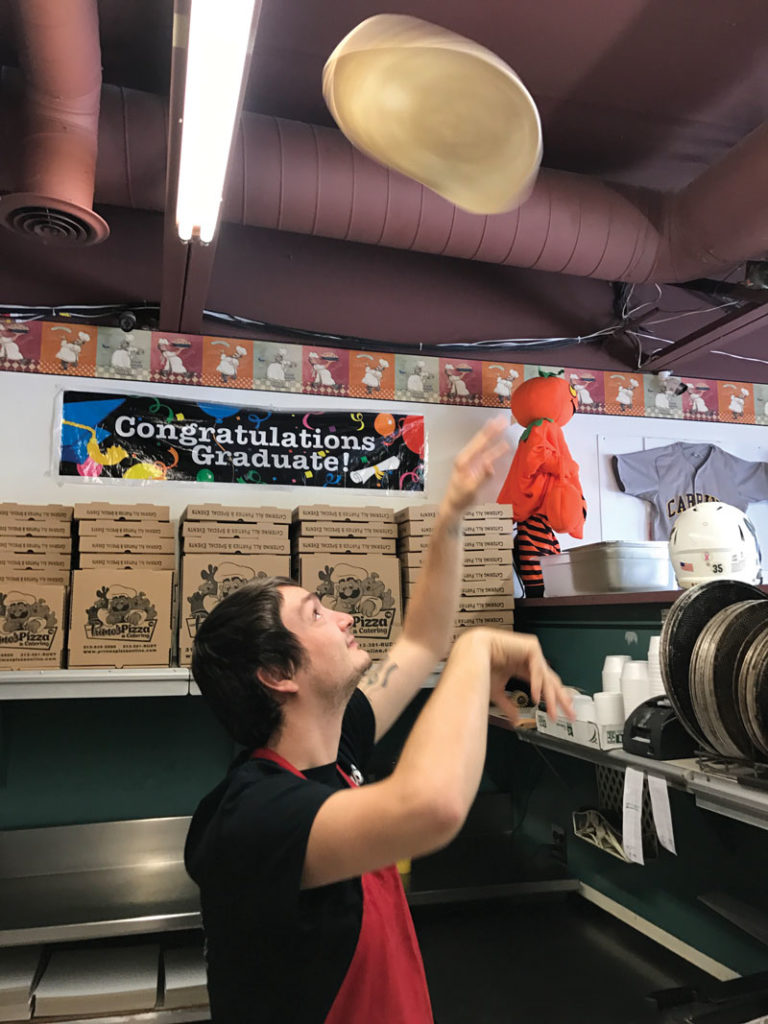 |
|
In this 2016 photo, Timmy Estheimer spins dough at his dad’s Primo’s Pizza store, which offers five flavored crusts. |
“Five or six flavors seem to be a good amount to offer some variety,” Estheimer explains. “We like to keep it consistent and simple, so we don’t make any proprietary blends; we buy them premade.” Roughly 50% of his customers choose a flavored crust, he says, and 50% of those choose the two most popular flavors: Garlic Butter or Garlic Butter Parmesan.
With nearly 600 locations, Hungry Howie’s, based in Madison Heights, Michigan, has revolved its entire menu around flavored crusts, with eight options: Butter, Asiago Cheese, Butter Cheese, Cajun, Onion, Ranch, Garlic Herb and Sesame. “Flavored crust is what sets our pizza apart, period—it’s the concept that our founder built the business on and what we’ve become known for over the past 40-plus years,” says Steve Jackson, CEO. “Butter Cheese is a tried-and-true classic, but we love to give our fans options to switch it up. Our most unique flavor is sea salt, which adds a savory yet crisp flavor.”
If you’re just starting out, experiment with low-risk options and test the waters. Try universally popular flavors or those that require little extra effort or supplies. “It’s easy to brush butter or oil or sprinkle some hard cheese on a crust,” Spizzirri says. “Adding these to your current pizza lineup gives added value to your customer, without you having to source additional ingredients.”
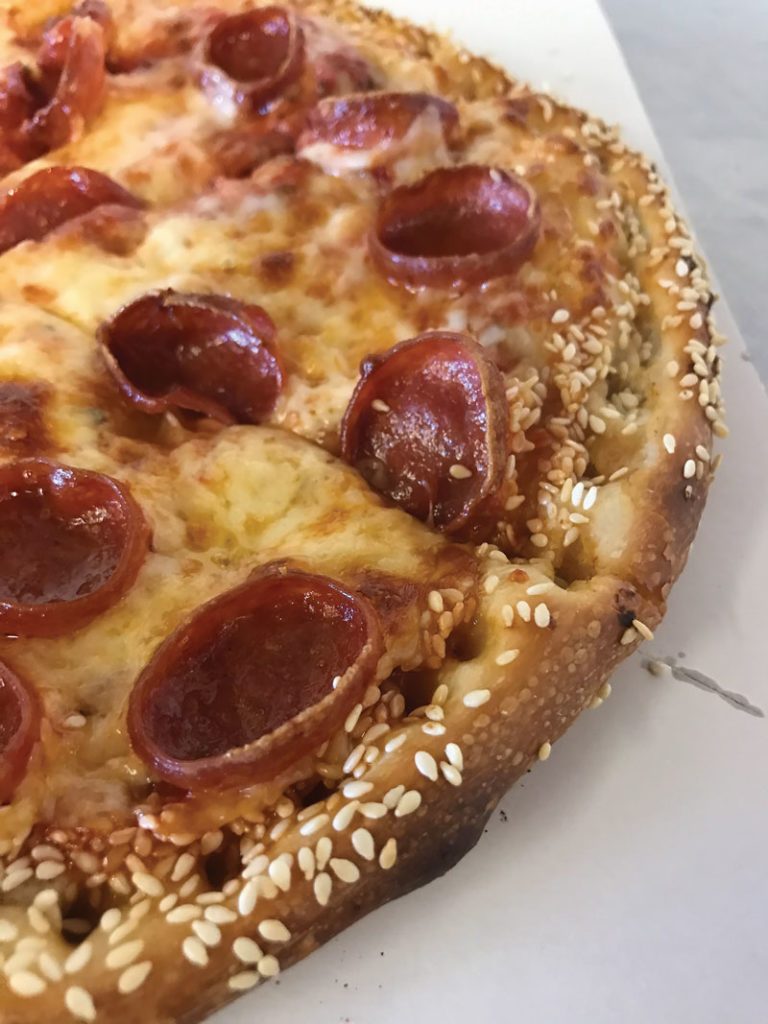 |
|
Sesame seeds add extra layers of flavor and texture to a classic pepperoni pie at Primo’s Pizza. |
Grand Experiments
Like pizza itself, ideas for flavored crusts are practically limitless; Spizzirri notes that ethnic and spicier flavors are all the rage right now. “I love being able to complement my toppings with a flavorful crust, so I’ve done Tikka Masala on a crust made with coconut cream, yogurt and turmeric powder, or shredded beef and pork on an empanada crust speckled with Mexican oregano inside the dough,” he explains. “I’ve even done a Wisconsin Beer Brat pizza that incorporated local craft beer in the dough. Just keep in mind, flavors should not overpower one another—they should develop layers of taste.”
Many operators try out new pizza crusts through limited-time offers (LTO), allowing them to suss out a crust’s viability while piquing customer palates. “We currently have eight core offerings, but we like to provide our customers with enough variety so they keep coming back,” Jackson says. “We offer limited-time flavors once per quarter.” Past LTO crusts at Hungry Howie’s have included Sriracha, Cheese Puff, BBQ Chip and Loaded Baked Potato.
Spizzirri agrees it’s often best to offer new items as LTOs, since certain flavors might be loved by some and considered polarizing by others. “I don’t feel that it’s wise to create an additional category on your menu until it’s been proven successful in the market,” he advises. “Put a special or two on the menu each month and track your sales. If something is doing really well, consider making it a permanent addition.” But, Spizzirri cautions, too many new things can confuse customers; try changing up seasonally so that menus always offer something new alongside your core items.
Indeed, most operators find that experimentation is key. “As we add new specialty pizzas, we’ll add more flavors—for example, Mexican pizza with taco seasoning sprinkled on the crust,” Estheimer says. “We’re also adding S’mores Dipping Sticks to the menu, with cinnamon-sugar in the crust. The possibilities are endless, but we keep in mind that the flavoring is there only to enhance the pizza, not take it over.”
| Potential Pitfalls |
| Are flavored crusts ever a bad idea? In 2014, Pizza Hut revamped its brand and introduced a range of flavored crusts after extensive focus groups and millennial-facing marketing research approved the switch. But, only a few months later, execs admitted that sales had slumped. The lesson: Know your audience. “Flavored crusts are uncommon because of the wide range of people we feed,” says Leo Spizzirri, resident dough specialist at Little Lady Foods in Elk Grove Village, Illinois. “You never really know who likes what flavors, and a lot of restaurateurs won’t risk sales based on trends.” But, he adds, it’s also important to understand the science behind dough. “Ingredients like garlic or onion powder act as natural dough conditioners (making your dough soft and even causing it to break down if used at a high ratio), while cinnamon affects yeast activity and dough rise,” Spizzirri explains. “Flavored dough that isn’t selling as projected leads to additional waste and wreaks havoc on your numbers. It’s very easy for a good idea to turn sour if you’re not prepared!” |
Pricing and Positioning
Once you’ve developed your flavored crust, should you charge extra for the option? “Food cost needs to be considered, so I normally don’t add flavors to my crusts in day-to-day operations unless it’s a special,” Spizzirri says. “If the ingredients can make a menu item more premium, then the customer will be willing to pay for it, but you must understand your market. If your clientele doesn’t veer off the beaten path much, you probably shouldn’t be adding saffron or anything exotic.” His advice: Keep it simple and sensible, at least initially. If you’re adding an ingredient that you already stock (i.e., herbs purchased in bulk), keep the price the same as the normal menu item.
“In Michigan, flavored crusts are pretty common, and none of our competitors charge for this option,” Estheimer says. “We decided to offer them free to keep up with the competition, so we don’t want to spend too much time with the crusts’ preparation. I believe some markets could charge a small fee for this option, but it’s not something we can do in our market.”
Hungry Howie’s, too, allows customers to “crustomize” pizzas at no additional charge. The company even offers a website with a “What Crust Are You?” quiz and the ability to recommend a new crust flavor, for which fans can vote. “Flavored crusts are intrinsic to our business, so we don’t believe in charging the customer extra,” Jackson notes. However, he adds, a specialty crust needn’t be the base crust at a pizzeria; allowing customers to choose a “plain” option gives more variety and allows for customization only if desired.
Again, offering maximum options is key. “We include a flavored crust on almost all of our specialty pizzas, but it can also be added to any pizza,” Estheimer says. “Offering a flavored crust as your standard pizza might eliminate some of the market. While Garlic Butter and Garlic Parmesan are our most popular crusts, a lot of customers don’t like them. I think leaving it as an option is best.”
As Spirrizzi concludes, flavored crusts should remain consistent, something that everyone will enjoy and that complements your current toppings. “Garlic pairs well with a lot of ingredients, but some people are put off by it,” he notes. “Things constantly evolve in the food industry, but at the end of the day, people will buy only what they like!”

